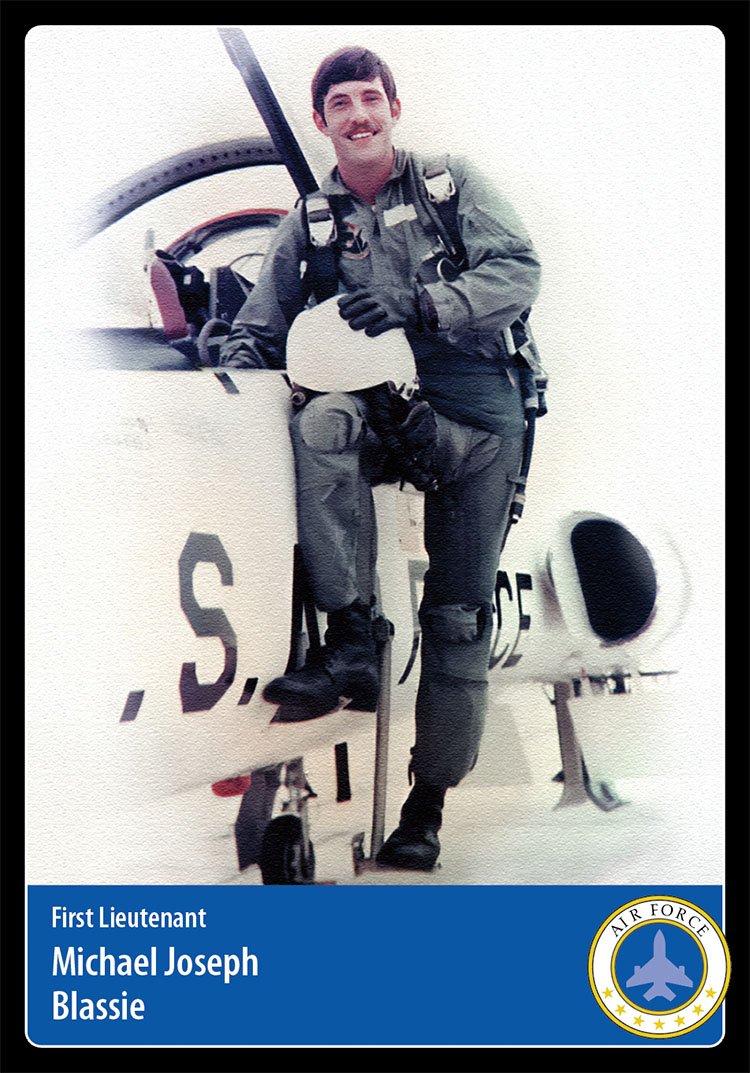Hero Card 193, Card Pack 17
Artist’s rendering by Craig Du Mez, from original photo
Hometown: St. Louis, MO
Branch: U.S. Air Force
Unit: 8th Special Operations Squadron, 377th Air Base Wing, 7th Air Force
Military Honors: Silver Star, Distinguished Flying Cross, Air Medal with 4 Oak Leaf Clusters, Purple Heart
Date of Sacrifice: May 11, 1972 - KIA near An Loc, South Vietnam
Age: 24
Conflict: Vietnam War, 1959-1975
For a time, he was the Vietnam War-era “Unknown” buried at the Tomb of the Unknown Soldier in Arlington National Cemetery. The Tomb serves as a symbolic grave for all war dead whose remains have not been found or identified.
Michael Blassie was born on April 4, 1948, in Florissant, Missouri—a suburb north of St. Louis. He was the oldest of George and Jean (Adrian) Blassie’s five children. After graduating from St. Louis University High School with the class of 1966, Michael was accepted at the United States Air Force Academy in Colorado Springs, Colorado, and received his commission as an officer in June 1970.
He was sent to Columbus Air Force Base in Mississippi for Undergraduate Pilot Training and earned his aeronautical rating as a pilot in 1971. After more training, Blassie qualified on the Cessna A-37 Dragonfly.
The Dragonfly was a small, light, jet-powered attack aircraft nicknamed the “Super Tweet.” The planes were relatively inexpensive, and because they could fly low and slow, could deliver their firepower more accurately than heavier conventional bombers. That accuracy came at a price: the Dragonfly was also more vulnerable to enemy ground fire than the higher-altitude bombers.
Deployment
In January of 1972, Blassie deployed to Vietnam with the 8th Special Operations Squadron, 377th Air Base Wing, 7th Air Force.
On the morning of May 11, 1972, 1st Lt. Blassie took off from the Bien Hoa Air Base in South Vietnam in his Dragonfly A-37. Just four months after arriving in Vietnam, he’d already flown 137 combat missions. On this day, he was targeting an enemy artillery position outside of An Loc, near the Vietnam-Cambodian border 60 miles north of Saigon.
Witnesses report seeing a burst of anti-aircraft tracer rounds firing at Blassie’s Dragonfly as he attacked the target in close combat. Blassie’s flight commander, Maj. James Connally described the attack in a letter to Blassie’s parents: “Mike’s aircraft was hit and began streaming fuel. He must have been killed instantly, because he did not transmit a distress call of any kind. The aircraft flew a short distance on its own and then slowly rolled over, exploding on impact in enemy-held territory.”
The next day, efforts were made to recover 1st Lt. Blassie and to inspect the wreckage. Heavy enemy fire prevented immediate access to the site, and Michael Blassie, age 24, was declared Killed in Action.
No Man Left Behind
Six months later, the allied South Vietnamese Army gained access to the crash site and recovered Blassie’s personal belongings and six bone fragments. All were sent to the Saigon Mortuary, then to a search and recovery center at Camp Samae San in Thailand, and finally to Hawaii’s Central Identification Laboratory.
With Blassie’s remains being separated from the personal belongings and other items from the crash site, a series of mistakes and flawed procedures led to his remains being reclassified as “designated unknown” and stored the Central Identification Laboratory in a file with the label “X-26.”
1st Lt. Blassie’s family was not informed that the crash site had been accessed or that remains were recovered. On Memorial Day, May 28, 1984, the remains designated “X-26” were interred as the Vietnam Unknown in a ceremony at the Tomb of the Unknown Soldier in Arlington National Cemetery.
No Longer “Unknown”
After years of political and media pressure from the Blassie family, former Army Green Beret Ted Sampley, and CBS reporters Eric Engberg and Vince Gonzales, in May 1998 the Pentagon and Defense Secretary William Cohen announced that the Vietnam Unknown would be disinterred—and DNA tested. Test results confirmed a perfect match with Michael Blassie’s older sister, Judy.
26 years after his Dragonfly was shot down, First Lieutenant Michael Joseph Blassie’s remains were returned to his family in St. Louis, Missouri, where he was laid to rest at Jefferson Barracks National Cemetery.
In Honolulu Hawaii, 1st Lt. Blassie’s name is engraved on the American Battle Monument Commission’s “Courts of the Missing,” along with the others who are missing from the Vietnam War. As is the custom, a rosette has been placed next to his name to indicate that he has been found.
Blassie is honored at the Vietnam Veteran’s Memorial in Washington D.C., his name inscribed on Panel 01W, Line 23.
Michael Blassie’s younger sister, Patricia—who served as an Air Force Colonel and was 13 years old at the time of his death—remembers, “He was strong, he was fearless, and he loved what he was doing. He was the heart, the soul, and the spirit that is America.”
Sources
Artist’s rendering by Craig Du Mez, from original photo
Vietnam Veterans Memorial Fund: Michael Blassie
Military Officers Association of America: Tomb of the Unknowns: Reclaiming a Brother in Arms
Defense POW/MIA Accounting Agency: 1st LT Michael Joseph Blassie
Columbus Air Force Base: Who is Blassie?
Military Times—the Hall of Valor: Michael J. Blassie
The Washington Post: Last soldier buried in Tomb of the Unknowns wasn’t unknown
Veterans Breakfast Club: The Secret of File X-26: How Lt. Michael Blassie’s Remains Were Rescued from the Tomb of the Unknown Soldier
HonorStates.org: Michael Joseph Blassie
Historical Marker Database: First Lieutenant Michael J. Blassie
Burial Site: Find a Grave





